Queen Elizabeth II's state funeral was held today in London's Westminster Abbey at 6 a.m. ET. President Joe Biden and first lady Jill Biden were among hundreds of world dignitaries who paid their respects to the late queen, who died Sept. 8 at the age of 96.
Our contributors today were MSNBC Daily writer and editor Hayes Brown, MSNBC Daily columnists Anthea Butler, Natasha Noman and Emma Gray, and Roberta Fiorito, co-host of “Royally Obsessed."
Here's what next for the funeral procession
The procession is set to arrive at St. George's Chapel at Windsor Castle around 11 a.m. ET (4 p.m. local time). After the queen's coffin is carried up the steps, her committal service will begin. It is expected to last about 45 minutes.
The third and final stage of the state funeral service will be a private burial scheduled for 2:30 p.m. ET (7:30 p.m. local time).
What was notable about Sarah Ferguson's seat at the funeral
The Duchess of York, Sarah Ferguson — affectionately known as “Fergie” — attended the queen's state funeral at Westminster Abbey today. She was seated in the second row next to her daughter Princesses Eugenie and son-in-law Jack Brooksbank. She sat behind the Prince and Princess of Wales and their two children. She sat across the aisle from her disgraced ex-husband, Prince Andrew.
The duchess has been mostly absent from official gatherings of the royal family since her divorce from Andrew in 1996, including Prince Philip’s funeral in 2021, so this gesture of inclusion from the royal family speaks volumes about the late queen’s enduring affection for her former daughter-in-law.
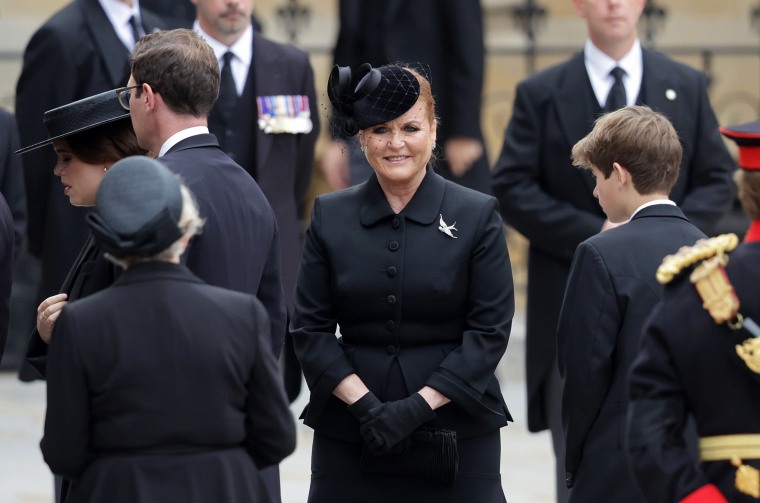
Why the Westminster Abbey bells are 'fully muffled' today
A quick bit of historical trivia: The bells of Westminster Abbey ring out “fully muffled” — a soft, somber peal — as the queen’s coffin makes its way through London and toward Windsor. The full muffled ringing of the bells only occurs after the funeral of the sovereign and will continue throughout the afternoon.
Bells are half-muffled for Remembrance Sunday and All Souls’ Day, but are only ever fully muffled if a king or queen dies, which hasn’t happened for 70 years.
Here’s why the queen’s coffin is lined with lead
The queen’s coffin, made of rare and expensive English oak, was designed 30 years ago — it is also extraordinarily heavy as the coffin is lined with lead, which is why it required eight pallbearers instead of the traditional six. The coffin is lined with lead as it will be interred above ground in St. George’s Chapel at Windsor Castle and because doing so will slow the decomposition process.
The coffin also was designed to be more structurally sound than most, given the weight of the crown, sceptre and orb sitting atop it.
Lead-lined coffins is a royal tradition. Elizabeth I’s coffin also was lined with lead, in 1603.
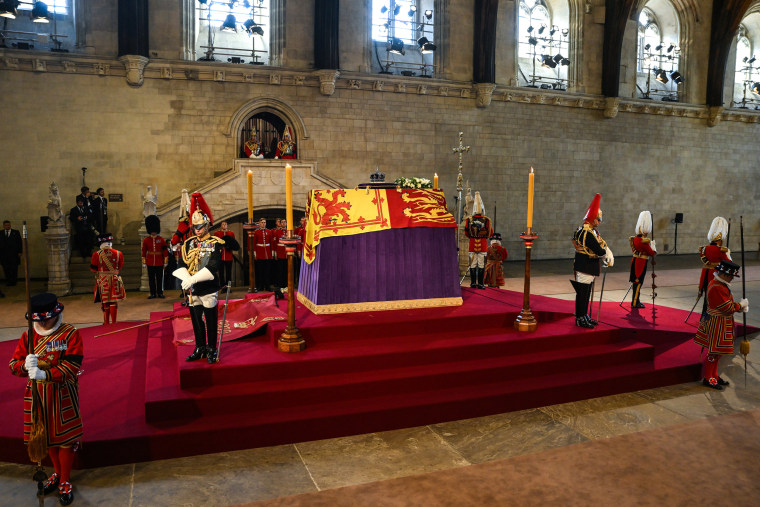
Queen reportedly helped design her own hearse
As the queen’s casket was loaded into the royal hearse, onlookers may have spotted a distinctive logo on the boot. Yes, Jaguar Range Rover designed the car with the Royal Household — and according to Bazaar.com, the queen gave her approval before her death:
The state hearse is finished in the shade Royal Claret, the same color as the official royal and state vehicles kept in the Royal Mews at Buckingham Palace and used by members of the royal family on official duties, per Buckingham Palace.
Elizabeth’s love of driving was well known, including a story of her scaring a visiting Saudi prince with her skills during his visit to her Balmoral estate in 1998.
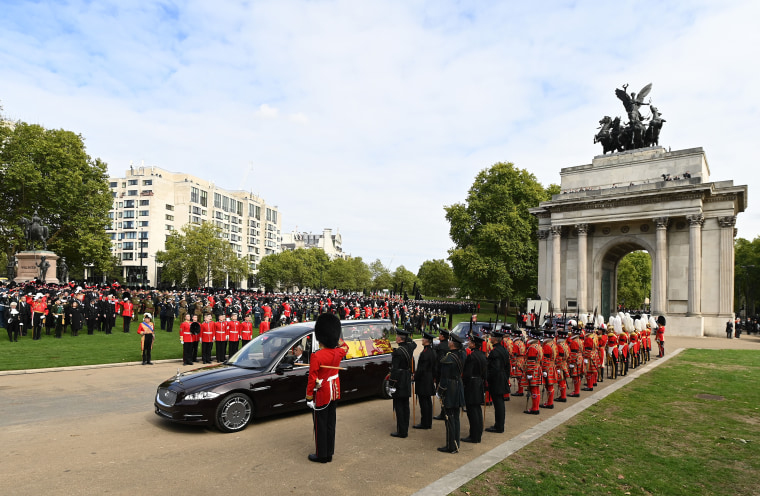
The queen as commander-in-chief
Today’s state funeral was a massively choreographed event. Many thousands of service members participated in the meticulously rehearsed funeral and procession. But as the coffin arrived at Wellington Arch, the show of military might was a striking reminder that in the U.K., it is the monarch, not the civilian prime minister, who is the leader of the armed forces.
During World War II, Queen Elizabeth II also made history as the first female member of the royal family to serve in the military; she joined the Auxiliary Territorial Service in 1945. The queen’s commander-in-chief duties will now be passed to King Charles III.
Prince George, Princess Charlotte whisper to each other
The two eldest children of the Prince and Princess of Wales were finally let out of the car after a long procession through the streets of London and they most likely eager to be able to stand again.
George, 9, and Charlotte, 7, looked on as their great-grandmother’s coffin was moved from the gun carriage to a state hearse for the 25-mile trip to Windsor Castle. The royal kids, flanked by their parents, couldn’t help but whisper to each other as historic events unfolded before them.
Macron’s tribute captures the day’s tenor
French President Emmanuel Macron succinctly captured the tenor of the day in his tribute to the queen immediately after her death. “To you, she was your queen — to us, she was the queen,” he said.
The service in Westminster Abbey saw dignitaries from all corners of the world attend. Hundreds of thousands of people, from the Commonwealth and beyond, showed up to pay their respects to the queen as she lay in state and for the funeral procession. The queen’s death has produced a remarkable outpouring: Up to 4 billion people were expected to tune in for the funeral, according to one estimate.
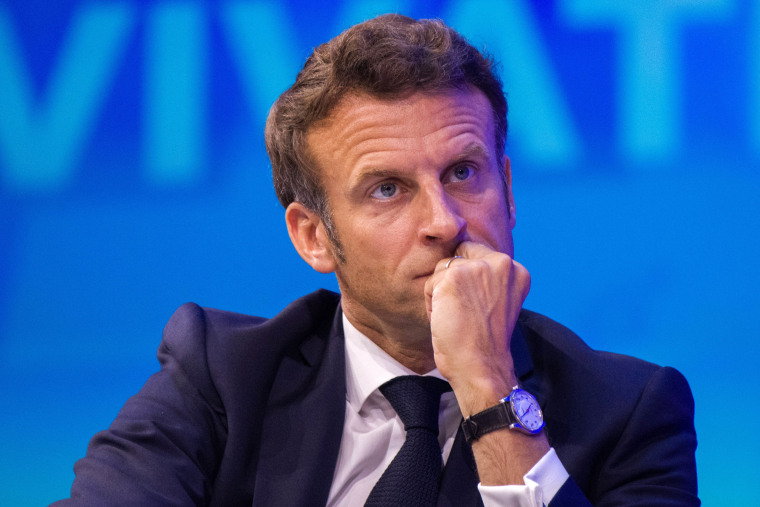
Procession running behind schedule
The procession is running about 30 minutes behind schedule. According to guidance released by Buckingham Palace ahead of the funeral, the queen's coffin was expected to depart for Windsor Castle in a hearse at 8:10 a.m. ET (1:10 p.m. local time). It's just departing now at 8:39 a.m. ET.
Plans for the funeral and its accompanying proceedings were made years in advance, and were rehearsed extensively by military and palace personnel.
Notable presence of Catholic clergy at the funeral of the queen
Notable Catholic participants in today’s funeral for Queen Elizabeth II were Cardinal Vincent Nichols of Westminster, Archbishops Leo Cushley of Edinburgh and Eamon Martin of Armagh (NI). The formal Vatican representative was Archbishop Paul Gallagher, who was born in Liverpool, England.
The Cardinal Nichols of Westminster reading prayers alongside the Anglicans, would’ve been unthinkable in 1952. It’s a first for a sovereign’s funeral post-Reformation. Card Nichols giving the prayer for the Commonwealth was an added significant touch.
Final portrait sets the tone for how queen will be remembered
Last night, Buckingham Palace released a final portrait of Queen Elizabeth II, taken in May at Windsor Castle by photographer Ranald Mackechnie. In it, the queen is beaming and polished, wearing pearls and two aquamarine jeweled brooches (gifts from her parents on her 18th birthday) but, notably, no crown. The image is carefully curated to set the tone for how the queen wished to be remembered: warm, regal, poised and feminine; a mother and grandmother to a nation.
As journalist and author of “HRH: So Many Thoughts on Royal Style,” Elizabeth Holmes wrote on Instagram, this portrait feels “true to the image [Queen Elizabeth II] carefully crafted for seven decades. … One last look at Her Majesty, as she wanted to be seen.”
Crowd applauds as the queen's coffin passes by statues of her parents
The otherwise subdued, silent crowd broke into a rare round of applause as the queen’s cortege and coffin processed past statues of her parents, King George VI and Queen Elizabeth, the queen mother, located halfway down the Mall. In 1952, the queen ascended the throne upon the death of her father, with whom she was said to be very close.
The queen will be placed alongside her husband again
The committal service for Elizabeth will bring back memories of her sitting alone at Prince Phillip’s funeral last year. This service St. George’s Chapel at Windsor Castle will include includes prayers and music.
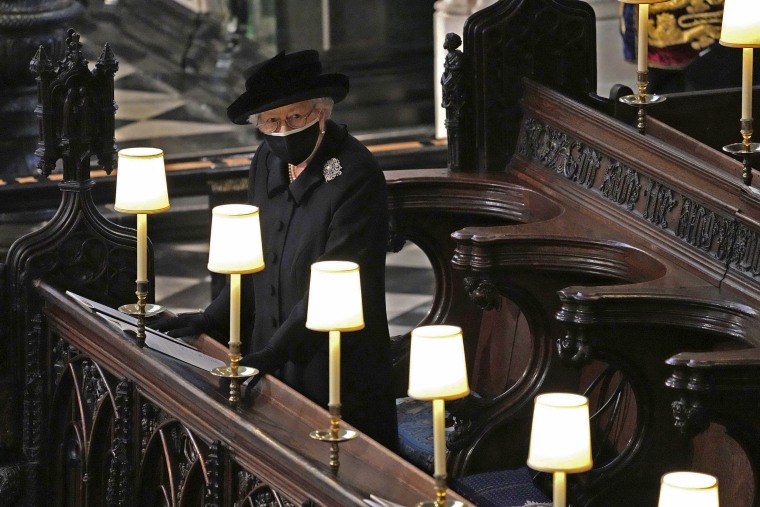
One of the more arresting rituals at the committal service will be the removal of the orb and scepter from the coffin of the queen, and the “breaking of the wand” which is the Lord Chamberlin’s last duty to break the wand of his office at the end of the service and to place it on the queen’s coffin. This symbolizes the end of his service to the queen. The current and final Lord Chamberlin to Elizabeth is Lord Andrew Parker, Baron Parker of Minsmere, appointed in 2021.
After the lowering of the coffin into the crypt, there will be one final service of prayers and burial for the queen, presided over by the Dean of Windsor. This will be for the immediate family only, and not televised. She will then be laid to rest alongside her husband, Prince Phillip.
Buckingham Palace staff lines up for final farewell
The staff of Buckingham Palace lined up outside the palace to bid the queen a final farewell as her coffin passed by during the walking procession. The queen regarded Buckingham Palace as her office, in contrast with Balmoral Castle and Windsor Castle, to which she had more personal attachments. The queen conducted much of her reign at the London palace, where the staff played an integral role for 70 years, working intimately with and for the queen.
“My whole life, whether it be long or short, will be devoted to your service,” the future queen said on her 21st birthday broadcast, when she was still princess.
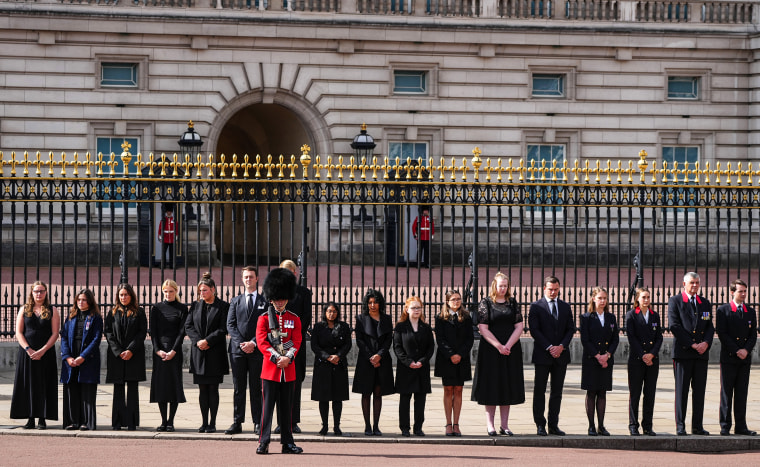
Crowds stand 15 people deep while watching in stunned silence
The crowds lining the funeral procession for the Queen are 15-20 people deep and number in the tens of thousands, according to Reuters. Many have camped out since last night in tents and with stepladders, and the throngs stretch along the Royal Mall, Hyde Park and the Forecourt of Buckingham Palace.
Giant television screens and loudspeakers projected the funeral proceedings as the hushed watchers held cell phones aloft to catch a glimpse of the royal family funeral procession.
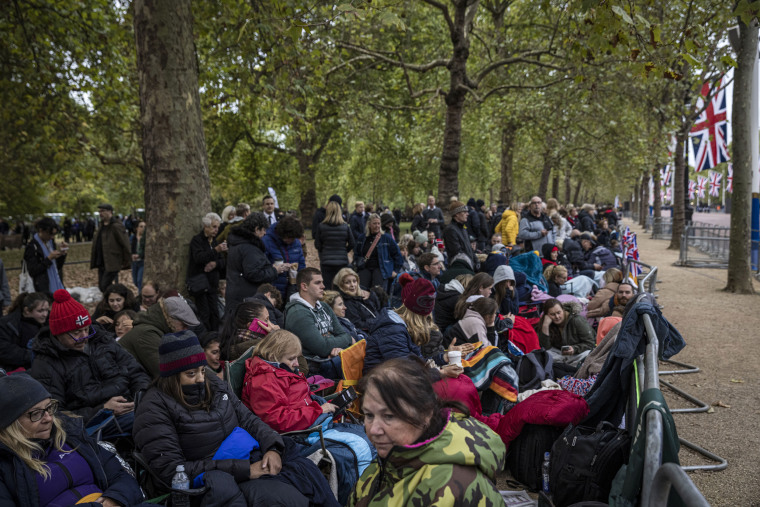
Queen’s coffin leaves Westminster Abbey for Wellington Arch
The walking procession through central London has commenced, as the queen’s coffin has departed Westminster Abbey for Wellington Arch in Hyde Park Corner. Spectators have waited long hours to watch the coffin and royal family, including military personnel — the procession is led by the Royal Canadian Mounted Police. Big Ben will toll and gun salutes will be fired for every minute during the procession.
After reaching Wellington Arch, the coffin will be transferred to Windsor Castle, its final resting place, via hearse.
Why Prince Harry and Meghan’s children are missing their great-grandmother's funeral
While Prince Harry and Meghan, Duchess of Sussex, joined the rest of the royal family for the queen’s funeral, presenting a united front, their children have been absent from the proceedings. There’s a simple reason why: Archie Harrison Mountbatten-Windsor, 3, and Lilibet Diana Mountbatten-Windsor, 1, have been deemed still too young by their parents to handle official royal events.
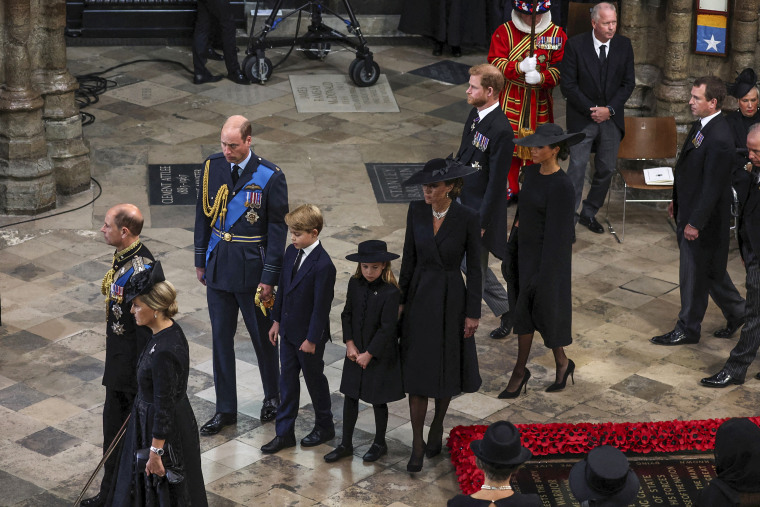
Hello Magazine reported that though there is “no official rule” that prohibits toddlers from attending the event, “those very young may be permitted to stay at home given the emotional gravity of the historic day.”
Prince Louis, 4, son of Prince William and Princess Catherine, also remained at home for his great-grandmother’s funeral, while older brother Prince George, 9, and sister Princess Charlotte, 7, attended the solemn ceremony.
Big Ben returns to service for queen’s funeral
The clock inside Parliament’s Elizabeth Tower has been undergoing upgrades and repairs since 2017. The bell inside, Big Ben, has been mostly out of commission during that time with regular “bongs” to mark the hour not expected to restart until this fall.
But the bell has been called to duty for Monday’s funeral — it will chime every minute until the roughly 45-minute procession from Westminster Abbey to the Wellington Arch is complete. That will be fewer than the 56 times it was rung out during George VI’s funeral, one for each year of his life. If the same honor had been planned for Elizabeth II, the bell would still be ringing out for long after her casket had departed.
Prolonged national mourning has coincided with medical backlog
As Britain has ground to a halt after the queen’s death, some of the inconveniences have included sporting event cancellations and shop closures, while others have been more serious, such as the cancellation of travel and medical appointments. The country’s standstill has coincided with the National Health Service being backlogged because of overextension.
“When I was called and told all appointments that day are canceled, I got off the phone and cried,” Dan O’Brien, who is eight months pregnant, told NBC News last week. O’Brien said she had waited three weeks for an appointment at a specialized maternity unit as she has Type 1 diabetes and therefore a high-risk pregnancy. “I only have six to seven weeks until I have my baby, so I feel like I’m running out of time to get the help I need before it becomes too much.”
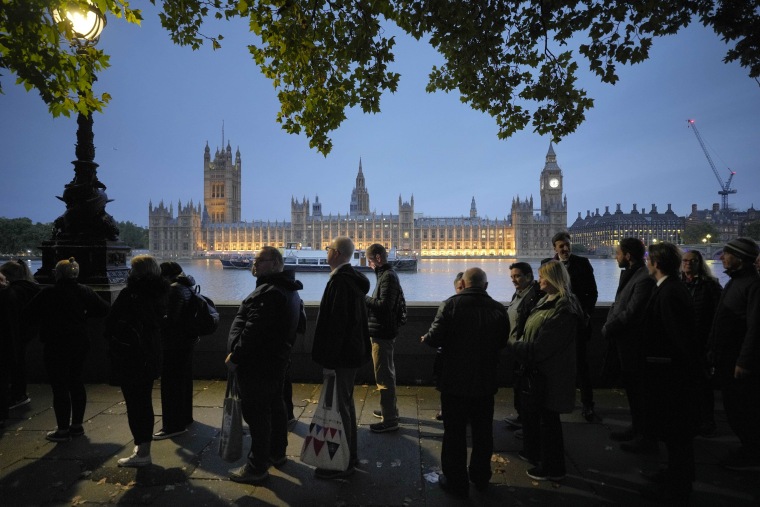
King Charles III's last words to his mother in heartfelt note atop coffin
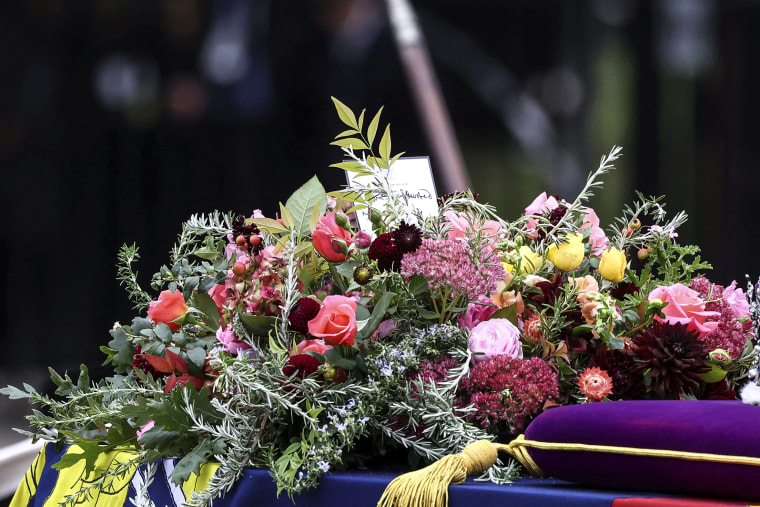
The bouquet on the queen's coffin contains flowers cut from from the gardens of royal residences as well as rosemary, English oak and myrtle (a flower used in the queen’s wedding bouquet). Atop the bouquet is a handwritten note from King Charles III. It reads: “In loving and devoted memory" and is signed “Charles R” for Charles Rex, a.k.a King Charles.
The symbolic veils worn by the Princess of Wales and queen consort
For the royal family, all choices — including clothing choices — are steeped in ritual. Catherine, Princess of Wales, arrived at Westminster Abbey with her children, Prince George and Princess Charlotte, wearing traditional mourning garb. One item that stood out was the veil attached to her hat.
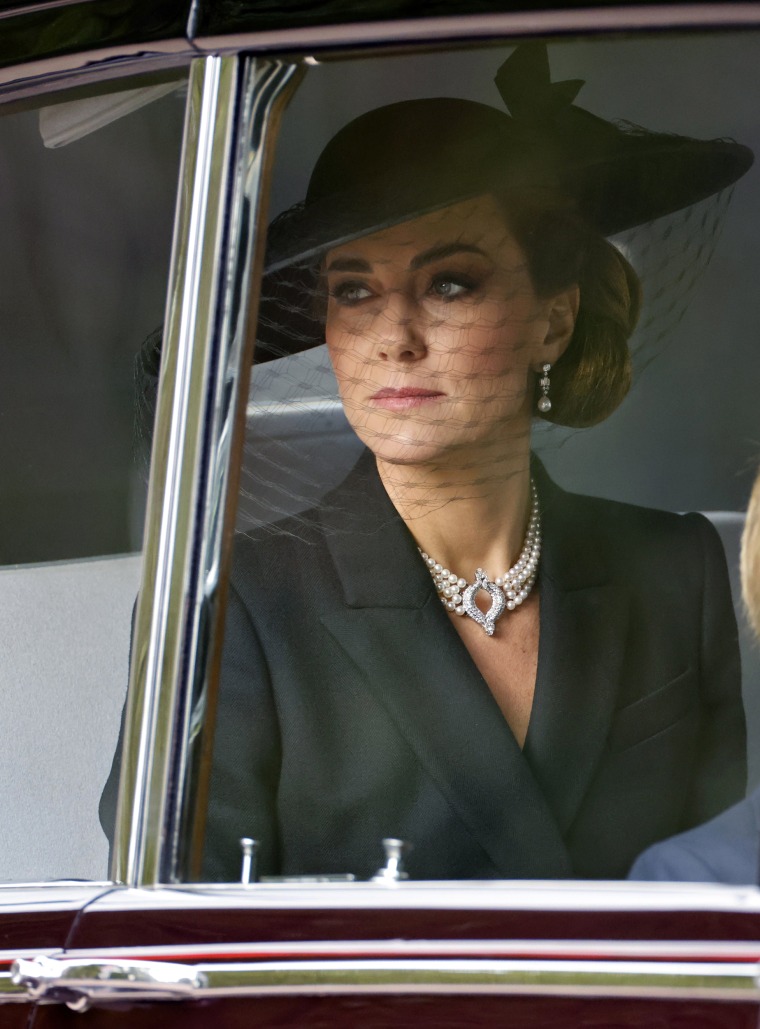
This “mourning veil,” which Camilla, the queen consort, is also wearing today, has become an important symbol for female members of the royal family, serving the dual purpose of overtly marking them as mourners and allowing the wearer to grieve with a bit of additional privacy.
Matthew Storey, curator at Historic Royal Palaces, told Express that it was Queen Victoria who helped establish this standard for modern royal mourning dress: “When her beloved husband died in 1861 she abandoned the colourful clothes of her married life and, with the rest of the royal court, adopted black clothing as an outward sign of grief. Her subjects duly followed suit, causing a rush on suppliers of mourning fabric up and down the country.”
In 1952, the newly crowned Queen Elizabeth joined her mother, grandmother and sister in wearing long black veils to her father’s funeral.
A change in royal lyrics
For 70 years, the people of the United Kingdom have been singing “God Save the Queen.” At today’s funeral services, with King Charles III in attendance, the lyrics were reverted to “God Save the King.”
It sounded at times as though some mourners were still used to the previous version — but given the circumstances, they could be forgiven for one last lyrical tribute to Elizabeth.
The bishops who were notably absent from assembly convened by Archbishop of Canterbury
Episcopal Priest Broderick Greer of Denver reached out to me and shared something interesting about Justin Welby Archbishop of Canterbury and the Lambeth Conference, the primary means of joint consultation for Anglican leaders on internal Anglican matter.
“Notably absent were bishops from more theologically conservative provinces like Nigeria and Uganda,” Greer said. “Those in attendance largely felt like the conference was a success. The Anglican Communion has, in recent years, been riven asunder by questions of the status of women and LGBTQ people in the life of the Church."
Archbishop of Canterbury condemns the likes of Trump
“Those who serve will be long remembered, as those who cling to power and privilege will long be forgotten,” Justin Welby, the Archbishop of Canterbury, said in his sermon, making reference to the queen’s life of service. In so doing, he also juxtaposed the queen against the likes of Donald Trump and other anti-democratic populist leaders, to whom the queen quietly objected.
A fundamental component of the queen’s legacy lies in her soft power. In politicizing the service — which the queen was deeply involved in planning — it would seem her legacy of soft power prevails even in death.
'Sleep Dearie Sleep' played by queen’s bagpiper
At Balmoral, the queen had her bagpiper play for 15 minutes each morning, and her funeral is no exception.
Pipe Major Paul Burns will close out the funeral with this traditional piece, “Sleep Dearie Sleep” right before the coffin leaves the church and after the two minutes of silence.
A nation falls silent
At a little after 6:55 a.m. ET (11:55 a.m. local time) all of Britain officially paused for two minutes of planned silence in honor of the late monarch.
The significance of Kate Middleton, Meghan Markle's outfits
As to be expected, the royals are in mourning fashion at the queen’s funeral.
Kate Middleton, the Princess of Wales, is wearing a black coat dress by Alexander McQueen (she wore the same in white to Trooping the Colour in June of this year) and hat with netted veil. She’s also wearing the Four Row Japanese Pearl necklace and Bahrain pearl drop earrings, both of which she wore to Prince Philip’s funeral.
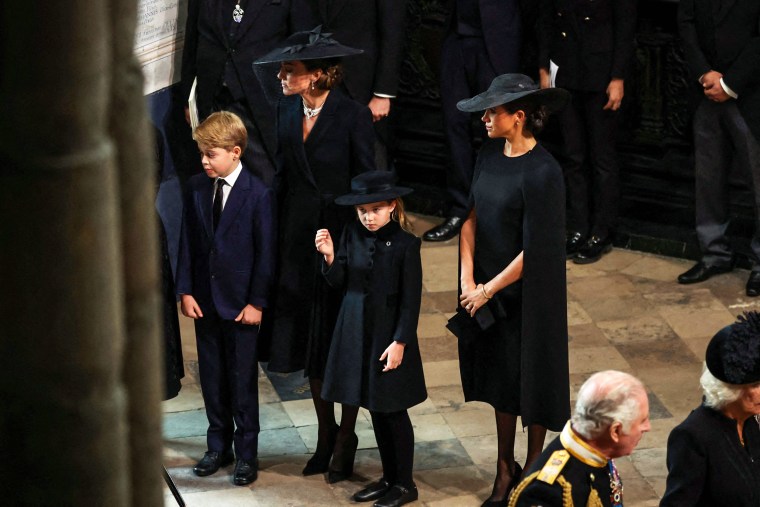
Meghan Markle is in a black cape dress by Stella McCartney (she wore the same in navy to the Queen’s 92nd birthday celebration).
But it might be little Princess Charlotte who stole the show in a small hat with bow and wool coat dress by Ancar Girls.
Funeral highlights England’s history of exclusive boys choirs
The queen’s funeral showcases Westminster Abbey’s choir, a group of 30 boys and 12 male professional singers who regularly perform at Britain’s most high-profile functions. It is not a choir for boys with stage fright.
Founded in the 14th century, the choir’s distinctive sound has a storied history. Being selected for the choir is an incredible honor — Westminster even maintains a special school for its choristers. But the pressure is similarly intense. In the late 15th century, Henry VII “issued a proclamation that a monastery official was to go around the country and take the pick of boys with the best voices who would have to come to the Abbey. If their parents refused they would be faced with the king’s ‘utmost displeasure.’”
Baroness Scotland of Asthal gives the first reading
Patricia Janet Scotland, Baroness Scotland of Asthal and the secretary-general of the Commonwealth, read from 1 Corinthians 15 to the congregation at the beginning of Queen Elizabeth II’s funeral.
The dual British and Dominica citizen has served as the sixth secretary-general of the Commonwealth since 2016 and is the first woman to hold the position.
A brand new prime minister says goodbye to the queen
There have been 15 U.K. prime ministers since King George VI’s funeral in 1952. But new Prime Minister Liz Truss had the job for less than a week before Elizabeth passed. Truss' reading at the queen’s funeral is one of the first official acts that she’s performed since taking over as the head of the British government this month.
The Archbishop of Canterbury’s long ties to the crown
Since the days of the Plantagenet kings and earlier, the Archbishop of Canterbury has been one of the preeminent members of the church, first in England and now Great Britain. Since the founding of the Anglican Church, it has been the head of the Anglican Community second only to the monarch.
Today the role has been held by Justin Welby since 2013, who delivered the sermon at Monday’s funeral.
While Welby has been an outspoken figure on Britain’s need to help the poor and needy, and critical of government cuts to welfare spending, he has not had the same sort of contentious relationship that past archbishops have had with his monarch. (Elizabeth, to our knowledge, never accidentally called for Welby’s death like Henry II did the archbishop Thomas Becket over 800 years ago.)
The crown atop the queen’s coffin is a symbol of colonial brutality
The Imperial State Crown, a potent symbol of the monarchy, rests atop the queen’s coffin. It is primarily known for its Koh-i-noor diamond (translated as “mountain of light” in Persian), which was in essence stolen from India during colonial rule. Despite very public calls to have the diamond returned, Britain has refused to return it since it was looted in 1849.
The British Raj had their eye on the diamond in the 19th century. “For the British, that symbol of prestige and power was irresistible,” as the Smithsonian explains. “If they could own the jewel of India as well as the country itself, it would symbolize their power and colonial superiority.”
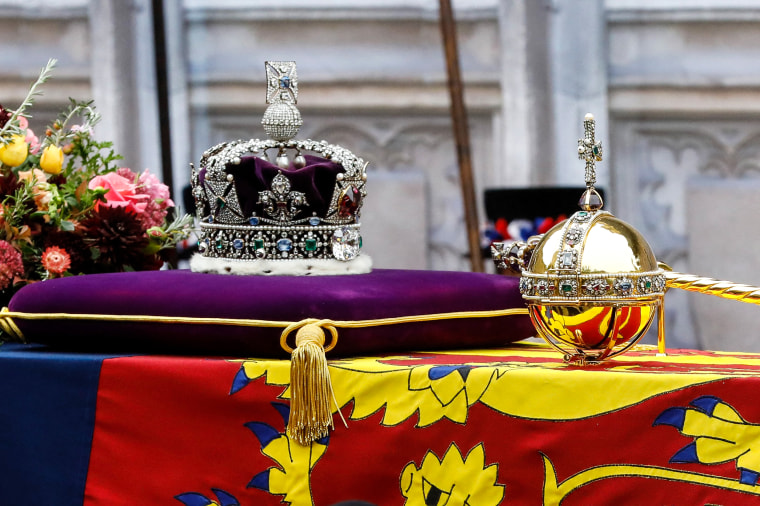
In 1849, during the Annexation of Punjab, the Brits coerced Duleep Singh, a 10-year-old royal, into signing over the diamond, after the empire imprisoned his mother. Once considered a symbol of conquest, it now represents Britain’s bloody colonial history and a refusal to reckon with its past.
“The actual histories of British imperialism tell a much different story, one of horrific violence, dispossession, prejudice and significant economic exploitation,” Danielle Kinsey, a Carleton University assistant professor of history, who focuses on 19th century Britain and empire, told NBC. “I think people are outraged by how the Koh-i-noor continues to function as a trophy of empire as long as it remains in the crown’s possession.”
During the funeral, the Imperial State Crown and the Sovereign’s orb and scepter will be taken off the coffin by the Crown Jeweller, as BBC reports, “separating the Queen from her crown for the final time.”
Readings at service are all done by government leaders
The representative for the Commonwealth was Patricia Janet Scotland, Baroness Scotland of Asthal and the sixth secretary-general of the Commonwealth of Nations.
It’s important to note that the readings in the service are by governmental officials, since there is no separation of church and state.
An early nod to Prince Phillip
The singing of the 23rd Psalm after the after the first and second scripture readings is not simply a liturgical feature of many Christian funerals, but it had special meaning to Elizabeth. It was sung at her wedding to Prince Phillip in Westminster Abbey in 1947. It is a nod to her love for her late husband.
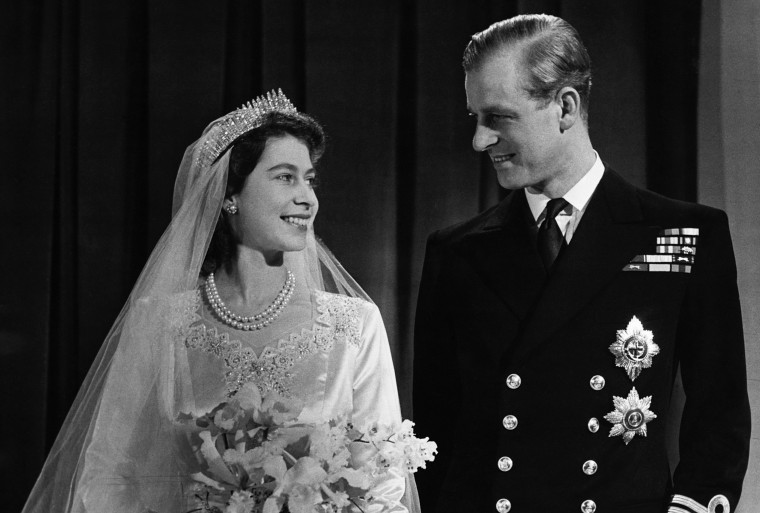
What to know as queen's coffin enters Westminster Abbey
In the procession of the family and clergy into Westminster Abbey, you’ll notice a clergy member with a long pole leading groups. That is called a verger, (or wandsman) who is tasked with ordering the religious service in the Anglican (Church of England) tradition. Following the coffin will be members of the royal family.

Even the flowers on Elizabeth’s casket are symbolic

Every bit of Monday’s funeral is meticulously staged and packed with symbolism, right down to the flowers on the queen’s casket. Here’s what Buckingham Palace has said about the floral arrangement and its meaning:
The wreath of flowers will include: At His Majesty The King’s request, the wreath contains flowers and foliage cut from the gardens of Buckingham Palace, Clarence House and Highgrove House. This includes foliage chosen for its symbolism: Rosemary for remembrance; Myrtle, the ancient symbol of a happy marriage, and cut from a plant that was grown from a sprig of myrtle in Her Late Majesty’s wedding bouquet in 1947; And English oak, which symbolises the strength of love. Also included are: Scented pelargoniums; garden roses; autumnal hydrangea; sedum; dahlias; and scabious, all in shades of gold, pink and deep burgundy, with touches of white, to reflect the Royal Standard, on which it sits. Again at His Majesty’s request, the wreath is made in a totally sustainable way, in a nest of English moss and oak branches, and without the use of floral foam.
Bidens hold hands, arrive shortly after 10 a.m. local time
The Bidens arrived at Westminster Abbey shortly after 10 a.m. local time and entered Queen Elizabeth II’s funeral holding hands — a show of affection and support which Prince Harry and Meghan Markle were recently criticized for.
The U.S. president was the only world leader permitted to arrive in his own presidential limousine. Part of the soft power of Elizabeth’s reign included her ability to bring world leaders together into the same space. Her funeral is a testament to that.
142 Royal Navy sailors draw Elizabeth’s casket
Elizabeth’s casket was loaded onto the state gun carriage outside of Westminster Hall ahead of the funeral service. The carriage is the same that was used to carry the casket of Elizabeth’s father, George VI, at his funeral in 1952, as well as those of monarchs back to Queen Victoria. Its last uses before Monday were for the funerals of Winston Churchill and Lord Montbatten.
According to the BBC, over 100 sailors drew the carriage the short distance between the hall and abbey, as drums and bagpipes played. The same team will draw the casket after the funeral to Wellington Arch, where it will be transferred to a hearse to be taken to Windsor Castle.
Prince George and Princess Charlotte take part in procession
Prince George of Wales, 9, and Princess Charlotte of Wales, 7, have joined the royal family in their procession into Westminster Abbey. Their participation in the funeral procession was revealed last night in the official Order of Service. They are walking behind their parents, the Prince and Princess of Wales, and in front of their uncle and aunt, the Duke and Duchess of Sussex.

An unprecedented security effort is underway in London
The biggest security initiative in Britain’s history is currently underway in London. The combination of a high-profile public procession, hundreds of thousands of spectators descending upon the city, and the assembly of world dignitaries and leaders has presented a unique security threat. Police officers from around the country have been diverted to London, assisted by a range of efforts from sniffer dogs to divers, as Reuters reports.
“It’s been decades since this many world leaders were in one place,” Sadiq Khan, the mayor of London, said. “This is unprecedented … in relation to the various things that we’re juggling.”

What to expect during today's funeral service
Hundreds of thousands of mourners have paid their respects to Queen Elizabeth II over the last several days. Many of them waited over 10 hours in a line referred to as The Queue, which reportedly stretched 5 miles at one point, to view the queen's coffin in Westminster Hall.
The lying-in-state portion of the public mourning period came to an end this morning at 1:30 a.m. ET (6:30 a.m. local time) when the last public mourner viewed the queen's coffin.
Here's the expected schedule via Buckingham Palace (all times in ET):
- 5:44 a.m.: Funeral procession and British royal family departs Parliament to arrive at Westminster Abbey by 5:52 a.m. ET.
- 5:59 a.m.: The queen's coffin enters Westminster Abbey
- 6 a.m.: Funeral begins
- 6:55 : Two minutes silence — Reveille — National Anthem
- 7 a.m: Funeral ends
- 7: 15 a.m.: Procession leaves Westminster Abbey as Big Ben tolls
- 8 a.m.: Coffin transferred to hearse at Marble Arch
- 8:10 a.m.: Hearse departs for Windsor Castle, where she will be buried in St George’s Chapel alongside her late husband, Prince Philip.
Will tragedy bring Prince William, Harry closer together?
While the world watches as some 500 dignitaries and leaders attend the first state funeral in the U.K. since Winston Churchill’s in 1965, many royal watchers will also be paying close attention to the interactions, or lack thereof, between the Prince of Wales and Duke of Sussex.
Was their reported family dinner at Buckingham Palace on Tuesday, and their drive-by “hello” at Windsor on Thursday, as reported by The Sunday Times, any indication of the thawing of their previously icy relationship?
Or is that just wishful thinking? According to The Telegraph, the Sussexes invitation to Sunday’s historic Buckingham Palace reception was rescinded — reportedly because it’s for working royals only. What’s more, eagle-eyed observers noticed the queen’s initials had been removed from Harry’s military uniform, which he wore to a ceremony on Saturday.
We will have to wait and see what impact this somber gathering will have on the brothers’ relationship.
The futility of trying to modernize the monarchy
Meghan Markle, the Duchess of Sussex, leveled explosive claims of racism within the monarchy during a highly watched interview last year with Oprah Winfrey. In response, Buckingham Palace reportedly considered hiring a “diversity czar” to help modernize the monarchy, but ultimately did not.
MSNBC Daily’s Zeeshan Aleem wrote recently that the episode highlights a fundamental truth that will be useful for the British to keep in mind as they contemplate the future of the monarchy: The institution simply can’t be culturally modernized.
“The British monarchy is, historically, one of the greatest engines of white supremacy the world has ever seen, having overseen the expansion of the most populous empire in global history and having enthusiastically supported slavery. Today the monarchy’s outwardly more enlightened diplomatic and philanthropic relationship with the Commonwealth provides cultural and legal cover for British Empire 2.0, whereby Britain is able to extract resources from postcolonial nations on hugely favorable economic terms. Domination of the Global South is baked into the monarchy’s DNA, and asking it to become a space for more equitable behavior isn’t just quixotic — it’s asking the wrong question."
Westminster Abbey plays royal funeral home for the first time in centuries
Westminster Abbey, with its Gothic arches and storied history, is one of the most enduring points of continuity in the British monarchy. Even before it was first used as a coronation site by William the Conqueror in 1066, it served as a resting place for Edward the Confessor. Since then, it has been the place where every reigning king and queen has been crowned, as well as where 16 royal weddings have been held.
However, a monarch’s funeral has not been held at the abbey since 1760, when George II was buried underneath the church. Since then, there have been only a handful of royal funerals held at Westminster. Elizabeth, like her father King George VI, will be interred at Windsor Castle after the funeral service is held.
More racist scrutiny awaits Prince Harry, Meghan Markle at funeral
All eyes will be on Prince Harry and Meghan Markle during the queen’s funeral. The U.K.’s latent racism towards the mixed-race couple returned in full force Wednesday during a ceremony initiating the queen’s lying-in-state, after they were spotted — wait for it — holding hands.
“The Royal Family leave our beloved Queen in Westminster Hall with grace and dignity except for Harry and Meghan who just have to hold hands like two lovesick teenagers. They really get on my nerves,” one frothing Brit proclaimed on Twitter. Others followed suit.
Outrage took hold in conservative corners across the nation, which failed to mention or take issue with the queen’s other grandchild, Zara Tindall, who also held hands with her husband, Mike, as they left Westminster Hall. The queen’s funeral will mark the most high-profile, official event since Meghan and Harry’s self-exiling and the stripping of their royal titles. And, if the lying-in-state-hand-holding scandal is anything to go by, the couple is sure to be highly scrutinized — and saddled with racial double standards.
Will Prince Andrew’s presence distract from the queen’s funeral?
Prince Andrew, the third child of Elizabeth and Prince Philip, was forced to step back from his public duties in 2019, after he was accused of sex trafficking a minor in connection to convicted sex offender Jeffrey Epstein.
The queen’s funeral, and the rituals surrounding it, mark Andrew’s temporary return to public life. And for many, it is an unwelcome one given his yearslong ability to evade significant consequences for these criminal allegations. (He settled a civil case with accuser Virginia Giuffre in February, though he did not admit guilt in the case.) It also serves as a reminder of the queen’s attempts to protect her son.
The public does have the right to protest at royal events, something London’s Metropolitan Police confirmed explicitly in a statement. However, a man was charged with breaching the peace in Scotland earlier this week after allegedly heckling Andrew as he walked behind the queen’s coffin.
Biden among hundreds of world dignitaries to attend funeral
President Joe Biden and first lady Jill Biden will represent the United States at this morning’s funeral.
Of course, scores of other foreign dignitaries also will be in attendance. According to Reuters, King Charles III was scheduled to host a reception for the world leaders at Buckingham Palace the day before the funeral.
Among the heads of state not invited: Russian President Vladimir Putin.
Nations begin angling to break free from Britain
Even in the 21st century, the British monarchy’s reach remains expansive, with a continued presence as head of state in more than a dozen other nations.
After Elizabeth's death several of those countries could soon seek a reset in their relationship with Britain. For instance, the prime minister of Antigua and Barbuda, Gaston Browne, told London-based ITV News that his country would hold a referendum on removing Elizabeth’s successor, King Charles III, as head of state.
As Ja’han Jones wrote for The ReidOut Blog last week:
“Thanks to centuries of violent and exploitative invasions, Britain has retained a foothold in 14 Commonwealth ‘realms’ outside the United Kingdom. They are Antigua and Barbuda, Australia, the Bahamas, Canada, Grenada, Jamaica, New Zealand, Papua New Guinea, Belize, the Solomon Islands, Saint Kitts and Nevis, Saint Lucia, Saint Vincent and the Grenadines, and Tuvalu.
But even before Browne’s announcement there were signs of breakage between colonized nations and their British invaders. Just last year, Barbados formally removed Elizabeth as their head of state and became a republic. And according to Foreign Policy, Belize, the Bahamas, Jamaica, Grenada, and St. Kitts and Nevis have all shown interest in following a similar path.”
U.K. is grieving the loss of a religious leader, too
Elizabeth met with many religious leaders during her reign — including imams, five popes and the late American evangelical leader Billy Graham — and appointed seven Archbishops of Canterbury. While her role as a fellow religious leader may not immediately come to mind for many, she took an oath at her 1953 coronation that defined her standing within the Church of England.
As MSNBC Daily columnist Anthea Butler wrote recently:
“Because she was the monarch, Elizabeth’s titles included Defender of the Faith and Supreme Governor of the Church of England. She occupied a unique space among the world’s religious leaders, one often not recognized by the broader public. When she met with popes, evangelists and other religious leaders, she was meeting them as the leader of the Church of England.
The queen will be remembered for her consistent Christian faith, for being a moral and religious leader, for her steadfast church attendance and for her quiet mourning as head of church and state at the death of her husband, Prince Philip.”
During Elizabeth’s lifetime, Britain underwent demographic changes, resulting in an increasing number of Muslims, Christian evangelicals and people of other faiths — and fewer people belonging to the Church of England. In his first official speech as monarch, King Charles III indicated he will strike an inclusive tone as the new Defender of the Faith, saying that “whatever may be your background or beliefs, I shall endeavor to serve you with loyalty, respect and love.”
Today's state funeral is the U.K.'s first in 57 years
Queen Elizabeth II's funeral marks the U.K.’s first state funeral since Winston Churchill’s on Jan. 30, 1965.
He is among the few British prime ministers to receive a state funeral, which usually are reserved for the monarchy. For such a funeral to be held for someone outside the royal family, approval must be granted by both the monarch and Parliament.
According to America’s National Churchill Museum, the state funeral for Churchill, who led the country during most of World War II, drew 6,000 people and was the first given to a so-called commoner since the Duke of Wellington’s death in 1852.



